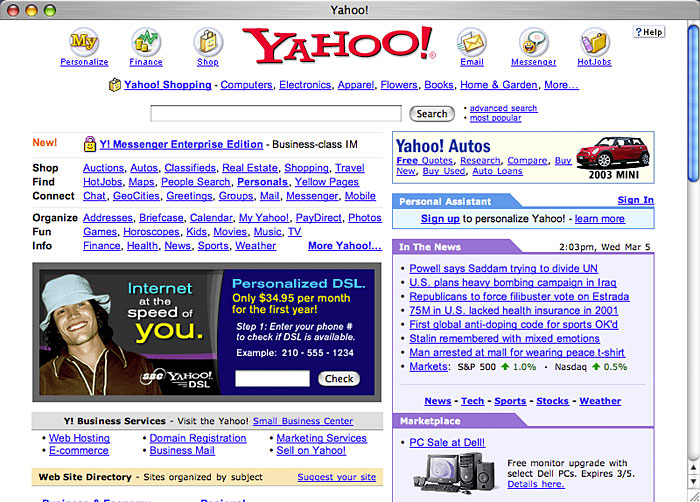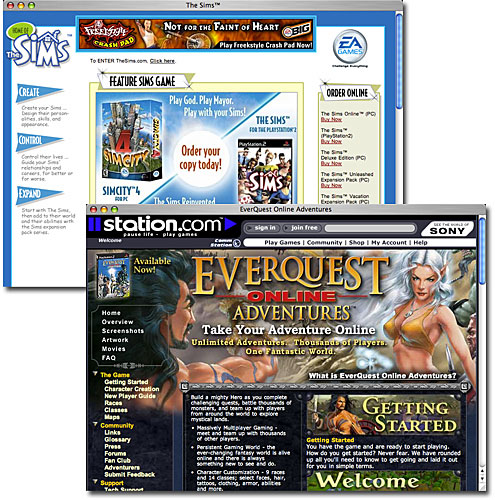MAT200A 03W
[Ben Lozano]
Data Driven Interactivity

Tim Berners-Lee
Images
Aerial
view of CERN
Enquire Manual (PDF)
CERN Proposal Diagram
WorldWideWeb Screenshot
Audio
Berners-Lee Lecture
Tim Berners-Lee
"Information Management: A Proposal" (1989)
"An important part... is the integration of a hypertext system with existing
data, so as to provide a universal system, and to achieve critical usefulness..."
The inventor of the World Wide Web, he was motivated to create a new system for the storing and retrieval of data through hyperlinks. While working at CERN in the early 1980's he proposed a system similar to a program he had written, called Enquire.
Enquire used an organizational system that focused on the relation of parts instead of a hierarchical structure that had been the normal way of retrieving data previously.
Berners-Lee saw that information should be available independently of having to know a system. He also wanted information to be platform and program independent. Ideally, data would be transported and read using a minimal formatting language.
This proposal laid down the ground rules for a hypertext
system:
• Remote access across networks
• Heterogeneity (compatibility between different systems)
• Non-centralisation
• Access to existing data
• Private Links
• "Bells and whistles" (ASCII text is essential, but some use of graphics
could be used to a certain extent)
In 1990 Berners-Lee completed the first web browser and server software, simply called WorldWideWeb. It ran only on the Next platform. From this program, a group of graduate students led by Marc Andreesen from the University of Illinois, Urbana-Champaign developed a browser called Mosaic for the Macintosh and PC.
Tim
Berners-Lee Official Website
Salon.com
Interview (September 15, 1999)
Speech
at the Smithsonian Institution (October 14, 1999)
Lecture at the Pacific Coast Center (October 20, 1999)
World Wide Web Consortium
CERN (European Organisation for Nuclear Research)
History of Hypertext
About Marc Andreesen
Mosaic Website
Deja Vu - Experience the history of the web!

Janet Murray
Janet Murray
"'Agency,' from Hamlet on the Holodeck"
(1997)
"In games, therefore, we have a chance to enact our most basic relationship
to the world—our desire to prevail over adversity, to survive our inevitable
defeats,
to shape our environment, to master complexity, and to make our lives fit together
like the pieces of a jigsaw puzzle."
In Hamlet on the Holodeck, Murray examines video games and how they relate to human nature. She uses the term "agency," which is the ability to take meaningful action and then see the results of those actions or choices. It is the interactivity that separates video games from other types of media. In a narrative story, the path is linear. In a video game, the a landscape is fixed. However, how a user gets from point A to point B may be very different.
Murray writes that most video games originate from classical story telling. The reason for this relates to agency. People know how stories work. There is a beginning, a conflict, then a resolution. Video games let people get into the story and affect the resolution.
Even games like Tetris, which seems to be just an abstract problem solving game, can be related to life. Murray makes the comparison of arranging the never ending falling shapes in the game to arranging the never ending tasks and problems in our daily lives. In the game and in life, a person arranges things as best they can. Ideally things fall into place and after a certain amount of time they disappear.
Hamlet on the Holodeck Website
Interview with PBS (October 13, 1997)
The history of video games
The Tetris Saga
Interactive: More Than A Buzzword
These two chapters focus on two different mediums, the World Wide Web and video games. However, both articles have a common theme: interactivity. Navigating a website and playing a video game by nature cannot be passive activities.
Browsing the web constantly calls upon the user to make choices. Where the user goes is based on their previous choice. Therefore, two different users who browse the same website can have very different experience, even though the same pages are available to both users. Even the names of web browsers imply going on a journey: Explorer, Navigator, Safari.
Similarly, a video game can give each user unique experience. Depending on the genre, a game can be a completely unique experience from start to finish. Some games like The Sims and Everquest don't even follow a traditional start-to-finish model. In these games, the user makes an endless series of choices and sees various results. There is no "ending," the user plays the game just to play the game.
Both browsing the web and playing a video game put the user in a fixed environment, but the non-linearity of these environments is what separates them from other forms of media.

